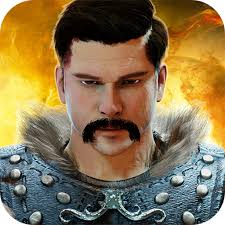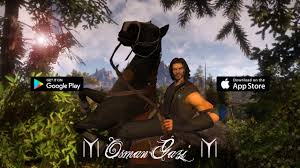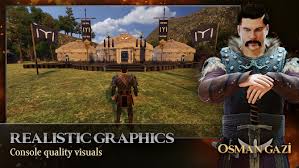Osman Ghazi Game
The Osman Ghazi Game has emerged as a captivating entry in the world of historical action-adventure gaming, immersing players in the epic saga of Osman I, the founder of the Ottoman Empire. This role-playing game (RPG), available on platforms like Steam and Google Play, transports players to the late 13th and early 14th centuries, a period marked by political upheaval and the rise of a nascent empire. By blending historical narratives with engaging gameplay mechanics, the game aims to bring Osman Ghazi’s legacy to life. However, its execution has sparked varied reactions, offering both thrilling adventures and notable shortcomings. This article delves into the game’s premise, mechanics, historical context, and its reception among players.

The Premise of the Osman Ghazi Game
The Osman Ghazi Game is designed to let players step into the shoes of Osman Ghazi, the legendary leader of the Kayı tribe, whose conquests laid the foundation for the Ottoman Empire. Spanning 82 episodes, the game follows Osman’s journey as he navigates challenges from the Byzantine Empire, Mongol invasions, and internal tribal conflicts. The narrative draws inspiration from real historical events, focusing on Osman’s role as a ghazi, or Islamic warrior, who expanded his principality in northwestern Anatolia. Players lead the Kayı tribe, engage in battles, and make strategic decisions to establish a burgeoning empire. The game promises an immersive experience with features like horse riding, sword fighting, archery, and castle sieges, all set against stunning 3D landscapes.
The storyline emphasizes Osman’s leadership qualities, portraying him as a wise and brave commander who unites his people against formidable foes like Crusaders and Mongols. By incorporating characters like Sheikh Edebali, Bala Hatun, and Turgut Alp, the game attempts to weave a rich tapestry of historical figures, drawing loosely from sources like the Turkish TV series Kuruluş: Osman. However, the narrative often prioritizes action over historical accuracy, blending myth and legend with fact, much like the scarce historical records of Osman’s life.
Gameplay Mechanics in the Osman Ghazi Game
The Osman Ghazi Game offers a variety of mechanics designed to immerse players in a medieval world. Players can engage in sword fighting, archery, and stealth missions, with the ability to customize their character’s weapons, armor, and even pets, such as a loyal steppe wolf. The game includes open-world exploration across diverse maps, from bustling markets to dense jungles, allowing players to interact with characters like Malhun Hatun and Bamsi Bey. Activities range from galloping on horseback to infiltrating enemy castles, climbing walls, and swimming to reach strategic objectives. The game’s interface is user-friendly, with a focus on action-based missions that require both combat skills and tactical planning.
However, the gameplay has faced criticism for its lack of polish. On platforms like the Nintendo Switch, reviewers have noted issues with clunky controls, particularly with menus that rely on touchscreen inputs while the game itself uses joycons. The missions often feel repetitive, with players following minimap prompts to engage in combat without deep strategic depth. Critics argue that the game fails to educate players about Osman’s historical significance, focusing instead on generic action sequences that could apply to any medieval setting.
Historical Context of the Osman Ghazi Game
The Osman Ghazi Game is set during a turbulent era in Anatolia, where the decline of the Seljuk Sultanate and the Byzantine Empire created a power vacuum. Osman I, born around 1258 in Söğüt, inherited a small principality from his father, Ertuğrul Ghazi. His leadership saw the capture of key Byzantine fortresses like Karacahisar and İnegöl, setting the stage for the Ottoman Empire’s expansion. The game reflects this context by portraying Osman’s battles against Byzantine tekfurs and Mongol forces, such as the pivotal Battle of Bapheus in 1302, which solidified his reputation as a ghazi.
While the game draws on historical events, it takes liberties with the narrative, much like later Ottoman chronicles that mythologized Osman’s life. For instance, the inclusion of Sheikh Edebali’s spiritual guidance and Osman’s dream of a great empire aligns with traditional stories but lacks contemporary evidence. The game’s portrayal of Osman as a near-invincible warrior also mirrors the romanticized depictions in Kuruluş: Osman, prioritizing drama over the sparse historical record of his reign.
Reception and Critiques of the Osman Ghazi Game
The Osman Ghazi Game has elicited mixed responses from players and critics. On mobile platforms, it has garnered praise for its ambitious scope and console-quality graphics, with some appreciating the ability to live out Osman’s conquests. The game’s action-packed sequences and customizable features appeal to fans of open-world RPGs. However, its execution has drawn significant criticism, particularly on the Switch, where it has been labeled as poorly optimized and buggy. Reviewers have called it “utter trash,” citing broken menus, lackluster AI, and a failure to deliver on its historical premise. The game’s potential to educate about Osman I’s life is undermined by its focus on repetitive combat over storytelling or historical depth.
Fans of Turkish historical dramas like Diriliş: Ertuğrul and Kuruluş: Osman find the game’s narrative familiar but lacking the emotional weight of its TV counterparts. For instance, Reddit discussions highlight how Kuruluş: Osman struggles to replicate the emotional stakes of Diriliş: Ertuğrul, and the game suffers similarly, with battles feeling inconsequential and lacking the gravitas of historical events. Some players, particularly from regions like Pakistan, have criticized the game’s dubbed versions for detracting from the experience, further diminishing its appeal.
The Legacy of the Osman Ghazi Game
Despite its flaws, the Osman Ghazi Game represents an ambitious attempt to bring Ottoman history to a global gaming audience. It taps into the growing popularity of Turkish historical media, offering players a chance to engage with a figure whose legacy shaped world history. The game’s strengths lie in its immersive world and diverse mechanics, but it falls short in delivering a cohesive and historically rich experience. For fans of action-adventure games and Ottoman history, it offers a glimpse into Osman’s world, but those seeking a deeper understanding of his life may need to supplement their experience with historical texts or dramas.

In conclusion, the Osman Ghazi Game is a bold but flawed endeavor. It captures the spirit of Osman I’s conquests but struggles with technical issues and a lack of historical depth. As Osman’s principality grew from 4,800 to 16,000 square kilometers, the game mirrors his ambition but not his strategic finesse. For players willing to overlook its shortcomings, it offers an entertaining, if simplistic, dive into the origins of the Ottoman Empire.
